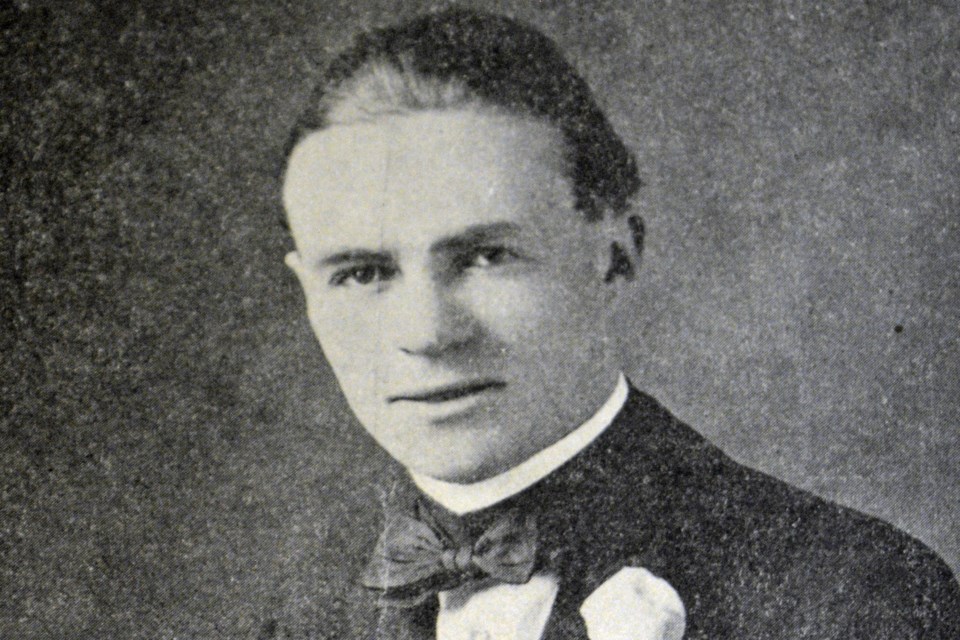INNISFAIL – Charles Maynard is being remembered as a man who overcame a tragic childhood to serve his country in two world wars.
Born in England in 1895, Maynard grew up in Innisfail before moving to British Columbia in his teenage years, where he enlisted to serve in the Canadian Armed Forces with the Canadian Expeditionary Force (CEF) in 1919.
Of the 630,000 Canadians who enlisted for military service with the Canadian Expeditionary Force, 424,000 went overseas as part of the CEF.
The Canadian Corps that fought on the Western Front was the CEF’s largest formation and its principal combat element, but not its only one. Other units in the CEF that served outside the corps included the Canadian Cavalry Brigade, forestry and railway units, and various medical hospitals.
A discharge certificate states Maynard enlisted in Esquimalt, B.C. in April of 1919, and served with the Canadian Army Medical Corps at the Esquimalt Hospital until December of that year.
“He was an opportunist in a positive way,” said Anna Lenters, board president with the Innisfail and District Historical Society. “He joined the forces for the First World War and Second World War. This was an opportunity to develop a profession.
“That’s where his medical profession began,” she added. “He was a nurse. He didn’t see combat but he would have been in the medical corps in (both wars),” explained Lenters. “He would have been a lot older when he served in 1939 to 1945.”
In 1922, Maynard spent time on the Morley Stoney Reservation in Calgary where he was adopted by a First Nations family.
“There’s a beautiful picture of him presenting the chief with his medals from the First World War,” said Lenters. “They were like family to him.”
Maynard also served in the Canadian Army Medical Corps from 1940 to 1946.
A certificate from the Government of Canada, dated March 1, 1945, was signed by Prime Minister Mackenzie King and noted Maynard’s enrolment as a volunteer worker for civil defence in the war against the German Reich. The certificate was one of thanks on behalf of all Canadians for his service during the Second World War.
Two years ago in 2017, Lenters and fellow board member, Andrea Ware, uncovered the fascinating details and story behind Maynard’s life.
“We had come across this box full of old letters and documents,” said Ware. “I slowly started reading and the story started to come, and then we really started to dig more and more.”
Since May, several artifacts, including handwritten letters, detailing Maynard’s life have been on display at the Innisfail and District Historical Village. Many of the letters were written to Dr. Margaret Godkin, a veterinarian and the museum's first curator. She is the grandmother of the village's current manager, Kayla Godkin.
His story, as written by Maynard, is also chronicled in the Candlelight Years, a book about Innisfail and area history that was first published in 1973. Maynard's entry is entitled, A Scion of Nobility.
Charles Maynard was born on April 15, 1895 in England into a life of nobility and was held by Queen Victoria at his christening.
His mother, Emma Warburton, was disowned by the family after she chose to marry a local actor, H.N. Maynard, who was beneath her societal status.
They moved to Canada and arrived in Innisfail in 1896. They bought a small ranch near Horseshoe Lake, east of town.
For Maynard, life as a young boy was tough. His mother died during childbirth in Innisfail in 1901 and was buried here. He was often alone, left by his alcoholic father to fend for himself, but at times taken in and raised by his mother’s former friends.
“Under what circumstances did he arrive here (in Innisfail), and what did his life look like?” queried Lenters. “It wasn’t a good story once he was here.
“I saw him as being a person of interest as a citizen of Innisfail,” she added.
Lenters said overcoming such adversity as a young child was a testament to his perseverance and his service in both world wars.
“It also speaks to the resilience of his character,” she said. “The fact that he, without support from his community and his mom and dad, pulled himself up by his bootstraps and saved himself.”
Maynard left Innisfail in his teenage years and moved to British Columbia with his father, Harry N. Maynard, who died in 1919.
In addition to his military service, Maynard was also a gifted pianist who played by ear and wrote his own music. He spent a short time in Hollywood, Calif. around 1916, where it is believed he worked as an actor before enlisting in the First World War.
Charles Maynard was a longtime resident of Edgewood and Kaslo, B.C.
In the 1960s Maynard settled down in Sidney, B.C. where he tragically died in a house fire years later, in 1985.



